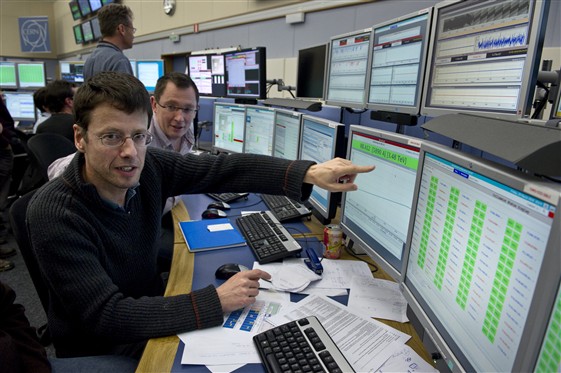LHC sets new record – accelerates beam to 3.5 TeV
CERN Operations Group leader Mike Lamont (foreground) and LHC engineer in charge Alick Macpherson in the CERN Control
 |
|
CERN Operations Group leader Mike Lamont (foreground) and LHC engineer in charge Alick Macpherson in the CERN Control Centre this morning. (photo from CERN website) |
“Getting the beams to 3.5 TeV is testimony to the soundness of the LHC’s overall design, and the improvements we’ve made since the breakdown in September 2008,” explained CERN1’s Director for Accelerators and Technology, Steve Myers. “And it’s a great credit to the patience and dedication of the LHC team.”
The current LHC run began on 20 November 2009, with the first circulating beam at 0.45 TeV. Milestones were quick to follow, with twin circulating beams established by 23 November and a world record beam energy of 1.18 TeV being set on 30 November. By the time the LHC switched off for 2009 on 16 December, another record had been set with collisions recorded at 2.36 TeV and significant quantities of data recorded. Over the 2009 part of the run, each of the LHC’s four major experiments, ALICE, ATLAS, CMS and LHCb recorded over a million particle collisions, which were distributed smoothly for analysis around the world on the LHC computing grid. The first physics papers were soon to follow.
After the 2.36 TeV collisions, a technical stop ensued at the beginning of 2010, during which the machine was prepared for higher-energy running. Higher energy collisions require higher electrical currents in the LHC magnet circuits. This places more exacting demands on the new machine protection systems, which have now been readied for the task.
Once 7 TeV collisions have been established, the plan is to run continuously for a period of 18-24 months, with a short technical stop at the end of 2010. This will bring enough data across all the potential discovery areas to firmly establish the LHC as the world’s foremost facility for high-energy particle physics.

Source: CERN Website